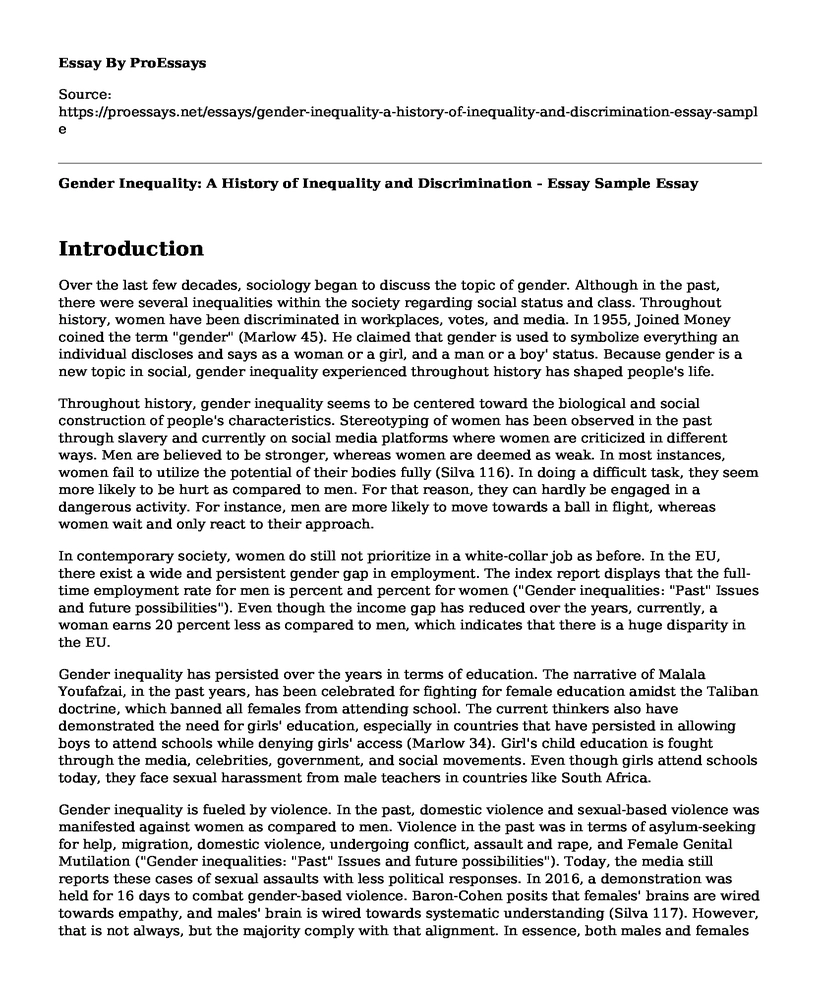Introduction
Over the last few decades, sociology began to discuss the topic of gender. Although in the past, there were several inequalities within the society regarding social status and class. Throughout history, women have been discriminated in workplaces, votes, and media. In 1955, Joined Money coined the term "gender" (Marlow 45). He claimed that gender is used to symbolize everything an individual discloses and says as a woman or a girl, and a man or a boy' status. Because gender is a new topic in social, gender inequality experienced throughout history has shaped people's life.
Throughout history, gender inequality seems to be centered toward the biological and social construction of people's characteristics. Stereotyping of women has been observed in the past through slavery and currently on social media platforms where women are criticized in different ways. Men are believed to be stronger, whereas women are deemed as weak. In most instances, women fail to utilize the potential of their bodies fully (Silva 116). In doing a difficult task, they seem more likely to be hurt as compared to men. For that reason, they can hardly be engaged in a dangerous activity. For instance, men are more likely to move towards a ball in flight, whereas women wait and only react to their approach.
In contemporary society, women do still not prioritize in a white-collar job as before. In the EU, there exist a wide and persistent gender gap in employment. The index report displays that the full-time employment rate for men is percent and percent for women ("Gender inequalities: "Past" Issues and future possibilities"). Even though the income gap has reduced over the years, currently, a woman earns 20 percent less as compared to men, which indicates that there is a huge disparity in the EU.
Gender inequality has persisted over the years in terms of education. The narrative of Malala Youfafzai, in the past years, has been celebrated for fighting for female education amidst the Taliban doctrine, which banned all females from attending school. The current thinkers also have demonstrated the need for girls' education, especially in countries that have persisted in allowing boys to attend schools while denying girls' access (Marlow 34). Girl's child education is fought through the media, celebrities, government, and social movements. Even though girls attend schools today, they face sexual harassment from male teachers in countries like South Africa.
Gender inequality is fueled by violence. In the past, domestic violence and sexual-based violence was manifested against women as compared to men. Violence in the past was in terms of asylum-seeking for help, migration, domestic violence, undergoing conflict, assault and rape, and Female Genital Mutilation ("Gender inequalities: "Past" Issues and future possibilities"). Today, the media still reports these cases of sexual assaults with less political responses. In 2016, a demonstration was held for 16 days to combat gender-based violence. Baron-Cohen posits that females' brains are wired towards empathy, and males' brain is wired towards systematic understanding (Silva 117). However, that is not always, but the majority comply with that alignment. In essence, both males and females have their weaknesses and strengths, making none superior over another.
Conclusion
In conclusion, throughout history, gender inequality seems to be centered toward the biological and social construction of people's characteristics. Gender inequality has persisted over the years in terms of education, violence, and employment. Men are believed to be stronger, whereas women are deemed as weak. In most instances, women fail to utilize the potential of their bodies fully.
Works Cited
"Gender inequalities: "Past" Issues and future possibilities." 12 2017, www.bbvaopenmind.com/en/articles/gender-inequalities-past-issues-and-future-possibilities/.
Marlow, S. "Gender and entrepreneurship: Past achievements and future possibilities." International Journal of Gender and Entrepreneurship, vol. 12, no. 1, 2020, pp. 39-52, doi:10.1108/ijge-05-2019-0090.
Silva, E. "Gender and inequality." Inequality in Economics and Sociology, 2017, pp. 111-121, doi:10.4324/9781315558936-8.
Cite this page
Gender Inequality: A History of Inequality and Discrimination - Essay Sample. (2023, Jul 24). Retrieved from https://proessays.net/essays/gender-inequality-a-history-of-inequality-and-discrimination-essay-sample
If you are the original author of this essay and no longer wish to have it published on the ProEssays website, please click below to request its removal:
- Obesity Prevention and Treatment in School-Aged Children Paper Example
- Annotated Bibliography on Culture Ethnicity and Schooling
- Predicting Homelessness Among Emerging Adults Aging Out of Foster Care Essay
- Essay Example on African Americans and Criminal Justice: Unequal Representation and Its Impact
- Media Coverage of Terrorism: Fear, Emotion, & Problematic Relations - Essay Sample
- Substance Abuse Rising: Adolescence & Young Adulthood at Risk - Essay Sample
- Civil Disobedience - Essay Sample







